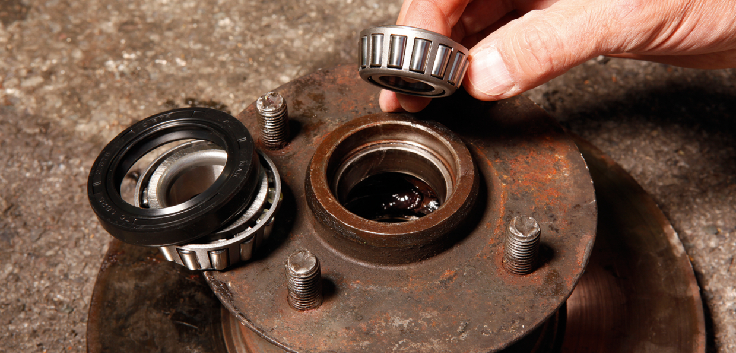Width
Current Selection:
Make
Current Selection:

Wheel Bearing Maintenance: What Is It And Why Is It So Important?
If you have been researching and trying to find relevant blogs that support your knowledge on wheels and tyres, this one should definitely go in your library.
We all know that solid and sturdy wheels are a must for every vehicle, regardless of its type or size. With good wheels, a car can function normally. However, there are just too many components in wheels, making it difficult to stay on track and know whether every single one is functioning as it should be.
Although simple, all of the components that are part of the vehicle’s wheels are integral to proper working wheels and rolling as expected. The wheel bearing is one of the most important elements in this manner, and the one that promotes wheel rotation through movement. However, servicing your wheel bearings is the best way to make sure that your vehicle is good for the road.
Below, we are expanding on this topic and going in detail about the potential issues with wheel bearing, and the need for regular maintenance. But first, let’s define this vehicle component.
What Are Wheel Bearings?
A wheel bearing is an essential part that is critical to the operation of the vehicle. It is the main link to the wheel and a part that assures that it is working as it should be. The wheel bearing does all of this by allowing friction-free movement and rotation of the hub assembly, thereby providing smooth tyre and wheel rotation.
The structure of a wheel bearing is simple – it consists of a set of steel balls (ball bearings) or tapers (tapered bearings) which are held together by a metal ring. This enables the wheel to rotate smoothly with a minimum of friction.

Also, you should know that wheel bearings are critical components that are designed to sustain radial and axial loads that are caused by gravitation, acceleration, braking and cornering and other forces, which is why they must be replaced once they are damaged or not working as they should be.
How Are Wheel Bearings Getting Damaged Or Broken?
There are several reasons behind failure with wheel bearings. We are listing the most common ones below:
- Faulty installation: Tools such as a hammer or a wrench can cause damage to your wheel bearing, causing your wheels to fail prematurely. Re-using old accessories (bolts, nuts, split pins, seals) is another common issue that leads to this problem. When installing new wheel bearings, make sure you are using new accessories and doing the process in the right way.
- Damage from the road/poor road quality: There are many factors that can damage a wheel bearing. Potholes,speed bumps, and curbstones are some of the common ways bearings get damaged.
- Poor quality wheel bearing: Every wheel bearing is performing under constant pressure, which is why it has to be made of quality and with the best materials. In some cases, the poor heat-treatment and low quality materials result in premature wear and failure.
- Driving conditions: Deep water, mud and other contaminants (dust, road salt, etc.) can all get past the seals and enter the bearing, polluting its grease and wearing it away.
- Car modifications: If you fit bigger rims than you are supposed to (or wider ones), put tyres with lower thread walls, absorbers or suspension springs, your wheel bearing will suffer from a greater load. In scenarios like these, problems with your wheel bearings are very common.
Now, diagnosing potential issues in your wheel bearing is the part that gets tricky for many vehicle owners. In order to do it, you must listen carefully but also know how this segment operates.

How To Check For Potential Wheel Bearing Problems
Even though there is no general rule of thumb, when it comes to wheel bearing issues, these are some of the best ways to check and make sure that the problem with your vehicle is coming from the wheels.
- Listening: The first and most logical way to check for wheel bearing issues are your ears. A bad wheel bearing typically produces a noise that can be easily mistaken as the engine noise. However, when you listen carefully, you are likely to hear grinding or grating which gets louder as your vehicle accelerates. This is one of the most telltale signs that your car needs wheel bearing maintenance.
- Loose when driving: If your vehicle feels loose when driving it, it is likely suffering from dysfunctional wheel bearings. If you don’t know what this loose feeling refers to, it is basically the steering of the vehicle which can get loose, including the wheel bearings. Wheel looseness is also known as wheel play, and is a common symptom that something is not right in your wheel hub and spindle.
- Lack of control: When a wheel bearing corrodes or becomes pitted, it is likely to produce vibrations, which are transmitted to the tyres. In scenarios like these, the car might feel like it is “pulling” to one side of the car or the other.
- Uneven tyre wear: Last but not the least is uneven tyre wear, which is another result of broken or damaged wheel bearings. If it’s paired with vibrations, you should immediately check the issue and probably invest in a set of new tyres once your wheel bearings are fixed.
Bearings are made of steel, which means that they can rust very quickly. This is why you need to regularly check them, but also keep them away from moisture, storage yards that are not gravelled or grassy areas. The steel is a magnet drawing the moisture and causing damage.

The Problem With Diagnosing Damaged Wheel Bearings
Wheel bearings have an average lifespan of 130,000 to 160,000 kilometers (85,000 to 100,000 miles). However, this is a rule of thumb, and there are bearings which can show signs of damage even after a couple of thousand kilometers. So, the actual lifespan of a bearing depends on the quality of the material, the operating conditions and other factors.
Still, what you should know is that the best way to see whether your wheel bearings are solid is by lifting your vehicle up, grabbing the top and bottom of the tyre and pushing and pulling alternately on it. When doing this, you should see a wheel that has very little play.
However, the problem is that many people cannot spot the difference of a sturdy and well functioning wheel and one that has damaged bearings. After all, you won’t get a confirmation of the problem unless you take the wheel apart and see the bearing from up close.
The good news is that our team at Tyres Online can help you diagnose the issue and give you an estimate. We work with high quality parts and offer a complete range of long-lasting wheel bearings that are engineered, tested and validated to all high standards for maximum performance and durability.
Schedule Your Regular Wheel Bearing Maintenance
Now is the best time to start thinking about your wheels.
With a simple call at 800-ALLTYRES, you can schedule an appointment and get an expert opinion on not just your wheel bearings, but also your car’s condition, quality of your tyres and a lot of tips that can help you save time and money in the future.
We are waiting for your call!




The information below is required for social login